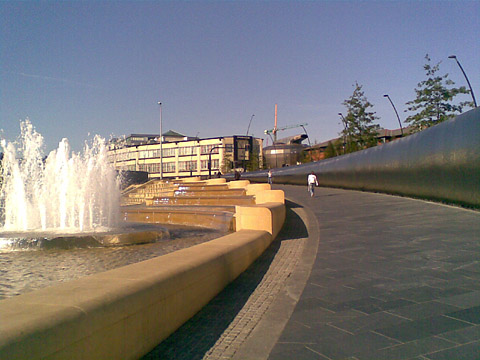
Landscape PING! in Wordle form.





A rather poor image of Sheffield's 'Gold Route'

Martha Schwartz's scheme as featured on 'Big Town Plan'
As it happens, you may have recently seen Martha on TV, cast in the role of pantomime villain on the Grand Designs spin-off, Big Town Plan. She was the highbrow, urbanite American designer (naughty Kevin McCloud never used the term landscape architect), who went against community wishes for a place to play bingo and walk their whippets, to force ahead with an art/paving/big-coloured-stuff fusion, which pretty much everyone else hated.
Certainly, Ms. Schwartz has her detractors and her most recent high-profile scheme, Grand Canal Square in Dublin, caused the usual flurry of publicity and criticism. Generally comments revolved around the fact that it is abstract, expensive and, I suspect, goes against the expectations of both the public and what many landscape architects, think landscape architects should be designing. From a personal perspective, I find it hard not to feel pangs of jealousy when I see the many bespoke elements, which frequent her designs, but perhaps more importantly the trust, scope and shear free-reign clients give her to create. How many other projects could have benefited from the budgets and creative freedom that Martha Schwartz enjoys? I also feel that perhaps her designs seem to work better in theory than in practice, although I’d caveat that by saying this feeling comes purely from looking at the initial visualisations of the project against press coverage, rather than having visited the scheme.

Grand Canal Square, Dublin - Finished image

Grand Canal Square - Initial Visualisation
But why is it that she is so unpopular with many landscape architects? In my opinion, to get the answer to this you need to have an understanding of one of the fundamental elements of design. For me, there is always a spectrum of how much your design inspiration comes from within a site or it’s context, and how much you bring in from outside. I don’t necessarily believe that either end of the spectrum is intrinsically right or wrong, but landscape architecture always begins within a site, in a way that the building doesn’t really have to. I suspect that many of the great works of architecture were actually dreamt up independently of their sites, and for want of a better word, ‘imposed’ upon them. Landscape architecture always begins with a site. For a variety of reasons, (such as legislation, poor standing with clients and a focus on landscape character assessment), many landscape architects see landscape design as valid only when it is realised in the character or context of the site. Thus, I believe that many see Martha Schwartz’s designs as being imposed. Ironically, I suspect that she herself sees the designs as having originated from within the site, only that they have been extracted and elaborated beyond where it is easily understandable.
Now at this point, I had meant to write about Martha’s conversations with the architect Will Alsop, however I think most people will have read enough by now. Needless to say, I’ve been impressed by Martha Schwartz’s recent comments to the press and think that she has articulated the difficulties faced by landscape architects in the UK better, and more intelligently than, anyone other else you could care to mention. I’ll finish with a comment someone left on a website regarding the Grand Canal Square scheme:
“awful BS. it does not look a like a sensual work to me, not what I would call landscaping, more like terrible art work.”